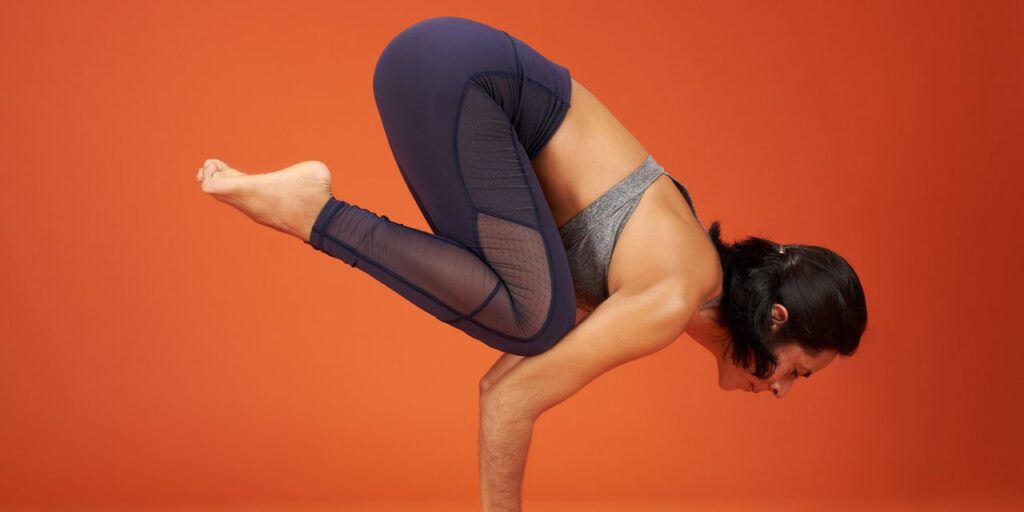[ad_1]
As for the practical energy profit? That comes from doing postures that interact numerous muscle teams concurrently and replicate each day actions like bending, lifting, pushing, pulling, squatting, rotating, side-stepping, and extra, she provides.
Yoga builds energy, however not essentially in the identical manner lifting weights does.
Following consistent with the practical profit, yoga typically strengthens throughout your whole physique, Candace Harding, DPT, a bodily therapist specializing in orthopedics and a registered yoga trainer in Arlington, tells SELF. That’s as a result of numerous courses interact giant muscular tissues in your legs, higher physique, and core by strikes like lunge variations, push-ups, and excessive plank holds.
However this doesn’t imply yoga smokes each single muscle you have got. To problem sure ones (like your lats, or your broadest again muscle, for instance), you actually need to select up weights and pull them towards you, use resistance bands or cables, or do strikes like chin-ups, inverted rows, and pull-ups that have you ever pulling the sturdy exterior load that’s your body weight—all belongings you probably wouldn’t encounter in a yoga class.
Utilizing this additional resistance can be vital in case your purpose is to enhance most energy and energy, Fryer says, since yoga probably doesn’t ship sufficient of a problem to reap these features. That’s as a result of in yoga, you’ll be able to’t make the stimulus heavier, because you’re restricted to simply utilizing your body weight.
Last factor: How a lot yoga counts as energy coaching is dependent upon how robust you might be to start with. “It makes a distinction the place somebody’s coming from,” Dr. Harding explains. For instance, if you happen to’re model new to train, you’ll most likely get numerous energy advantages from the apply, since transferring round your body weight will routinely be fairly robust for you, whereas if you happen to’re a daily gym-goer, you could not reap as many perks because you’ll have already got a stable baseline stage of energy. That mentioned, even skilled weight lifters may see features by including yoga to their routine, because it taxes your muscular tissues in a completely different manner, Dr. Harding says—it entails placing your muscular tissues beneath stress for a higher period of time than what they’d do within the fitness center when transferring heavier hundreds for shorter intervals. .
Are you able to take into account yoga a cardio exercise?
Cardiovascular train is usually outlined as something that calls for extra oxygen consumption and entails the cyclical, repeated motion of enormous muscle teams, Dr. Harding explains. So answering whether or not yoga counts as cardio “has lots to do with the tempo of the category,” she says.
As an example, courses that have you ever flowing repeatedly by actions—like vinyasa, energy yoga, and scorching yoga—can positively elevate your coronary heart fee and supply cardio advantages, Fryer says. Simply needless to say in comparison with extra conventional cardio actions like operating and biking, the cardio problem yoga provides is usually “on the extra delicate aspect,” Dr. Harding says. Slower-paced periods, like yin or restorative, wouldn’t present a cardio problem.
Much like the energy advantages, how a lot cardio yoga supplies is dependent upon your present health stage. “If somebody’s been sedentary, yoga could also be sufficient” to qualify as reasonable or probably vigorous-intensity cardio, Dr. Harding says. However for an already lively particular person, it might not deliver a ton of heart-boosting advantages.
Yoga additionally checks a couple of extra containers too.
For those who’re seeking to enhance your stability, yoga could be a sensible alternative. Actually any sort of sophistication that flows by poses (until it’s designated as “therapeutic” or “sluggish”) will problem your capability to maintain from wobbling, Dr. Harding says. Particularly, strikes that have you ever standing on one leg—like tree pose, eagle pose, and dancer’s pose—will take a look at, and finally bolster, your steadiness. Certainly, a 2015 meta-analysis of six research involving older adults printed in Age and Ageing concluded that yoga led to small features in stability, in addition to reasonable boosts in mobility.
[ad_2]


